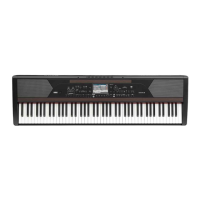Importing from a Standard MIDI File |253
The following events are stripped off the pattern, and automatically trans-
ferred to the Style Element header during the import procedure:
▪ Time signature (this event is mandatory)
▪ Control Change bundle #00-32 (Bank Select MSB/LSB)
▪ Program Change
Control Change #11 (Expression), Control Change 00, Control Change 32 and
Program Change messages must be placed at the very beginning of each
Chord Variation (tick 0).
Whenever they are not saved in the SMF, Program Change, Control Change
00, 11 and 32, can be still programmed in Style Record mode, by using the
edit features available.
Naming conventions
The naming structure for the Markers inside the SMF is ‘EnCVn’, whose sin-
gle components are shown in the following table:
Component Meaning
E Style Element (‘v’ = Variation, ‘i’ = Intro, ‘f’ = Fill, ‘e’ = Ending)
n Style Element number (‘1’~’4’ for Variations, ‘1’~’2’ for all other Style
Elements)
CV Chord Variation (‘cv’ = Chord Variation – no other choices allowed)
n Chord Variation number 1~6 for Variations, 1~2 for all others]
It is mandatory not to use capital letters in Marker names. Some examples
of valid names:
▪ ‘i1cv2’ = Intro1 – Chord Variation 2
▪ ‘v4cv3’ = Variation 4 – Chord Variation 3
Examples of non accepted names:
▪ ‘V1cv2’, ‘v1CV2’, ‘intro i1cv2’, ‘v1cv1 chorus’
The order of the Chord Variations inside the SMF is not relevant. They can be
freely placed inside the SMF.
Below, you can find a screenshot of a test file created in Steinberg Cubase,
just as an example of how a SMF separated by Markers can look like.
Considering analogies between actual workstations, it will not look much

